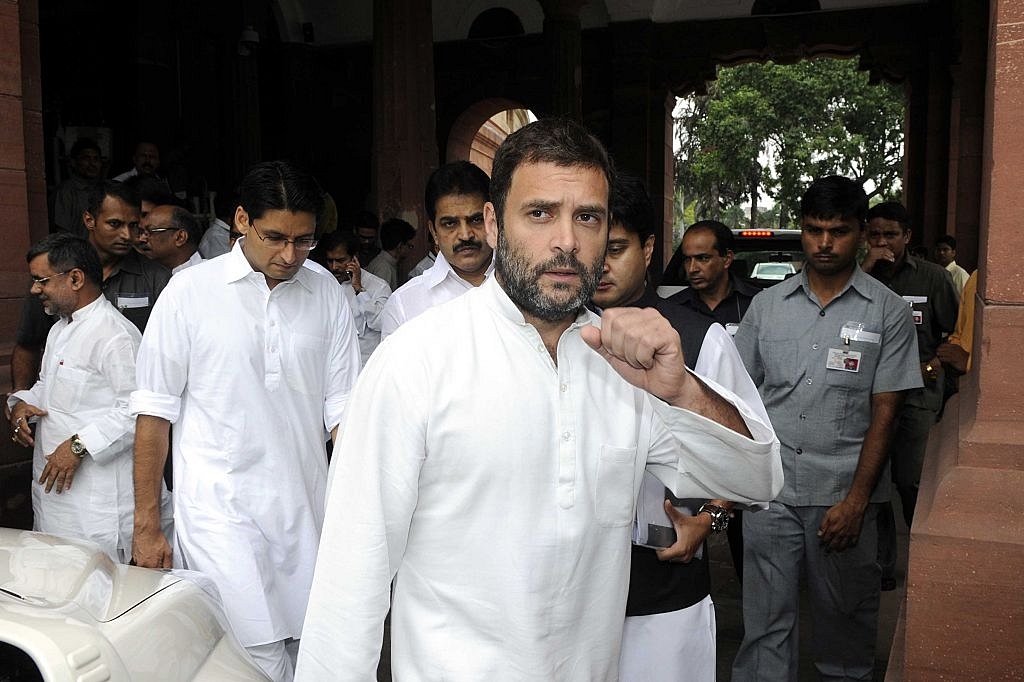Politics
Rahul Gandhi’s Op-Ed On Note Ban: More Fizzle Than Sizzle
- For a leader looking to be taken seriously, Rahul Gandhi is surely speaking too little on real issues and getting it wrong even in his occasional interventions.

Rahul Gandhi (Sonu Mehta/Hindustan Times via GettyImages)
We all have, sometime or the other, got convinced to watch a three-hour long movie after coming across its three-minute long power packed trailer, only to feel cheated off one’s money at the end. After going through Rahul Gandhi’s economic musings published in the Financial Times, I felt similar sentiments brewing within. Rahul Gandhi’s witty tweets with generous amounts of prose and poetry, had me believe that the new media-savvy but gaffe-prone vice president of Congress is finally coming into his own.
He had me hoping that, as time passes, his criticism of Prime Minister Narendra Modi’s economic policies would give way to an alternate economic vision. Just as it would not be wise to stretch the three-minute trailer into three hours of unending visual torture, it would have been smarter for the social media team of Rahul Gandhi to have restricted him to some occasional wisecracks, punches and one-liners rather than expect him to make a coherent argument of his economic ideas.
His supposed criticism of Prime Minister Modi’s demonetisation soon got caught up in his fear mongering on China. He pointed out towards China’s lack of individual rights as a factor in its rise as a manufacturing destination. He wrote, “Their (China) costs are lower than any of their western competitors; they manufacture at scale; and are not burdened by dissent, workers’ rights or the interruptions of transparency. According to official figures, China currently creates on average 50,000 jobs every single day; India under Mr Modi manages only 500.” His rant on China’s political system almost sounded like a eulogy till he clarified it is not the model India should emulate. In other words, he says China creates more jobs than India as if hinting that India should so too, quickly clarifying then that India shouldn’t become like China.
If China has surged ahead it is attributed to the reforms undertaken during Deng Xiaoping’s reign. Interestingly, Rahul Gandhi even mentions Deng, completely oblivious to the irony that while Deng was reimagining China economically, Rahul Gandhi’s own grandmother was busy sinking India deeper into an abyss. If Rahul Gandhi said the Chinese model chose growth over liberty, Indira Gandhi ensured India neither had growth nor liberty.
After a depressive and repressive era, a resilient nation was just beginning to recover in the 1990s and early 2000s, when Rahul Gandhi’s party slowed India down yet again. Under the decade long reign of United Progressive Alliance, investments in Indian manufacturing shrunk due to mammoth scams and policy paralysis. By the end of their term, India was being counted among the ‘Fragile Five’ with inflation in double digits, widening fiscal deficit and a slow pace of growth. Instead of introspection of his own government’s track record and telling us how he would do things differently, Rahul Gandhi is pointing fingers at China for creating joblessness in India.
In contrast, the World Bank’s Ease of Doing Business Report 2017 has shown India making a remarkable leap of 30 places, acquiring its place among the top 100 countries for doing business. With implementation of goods and services tax (GST), despite teething troubles, performance indicators are set to improve further, perhaps making it easier for small and medium businesses to formalise and operate better. However, criticising GST, which was backed by the chief ministers of the Congress ruled states too, shows that Rahul Gandhi is finding it difficult to find issues to counter the ruling party.
Another undercurrent of his Op-Ed alludes to his uncomfortable relationship with internet and new media. His last few months’ activities had given the impression that he had finally overcome his fear of the medium and is in a position to make the best use of it. However, in the article he almost made a case for restricting internet freedom to match Chinese productivity before he turned around and spoke of the future of liberal democracies, betraying utter confusion.
One can understand his paranoia. It has become increasingly difficult to mislead the public when everyone has equal access to information and the means to share it. His latest gaffe has taken the fizzle out of Gandhi’s social media campaign. Nandlal, the man whose forlorn image had become the poster for critics of demonetisation, was used by Rahul Gandhi to berate Prime Minister Modi on demonetisation. Ironically enough, Nandlal was actually reported to have praised Modi for demonetisation, only a few days back. Further, some news channels too played bytes of the same on 8 November too.
It seems that in a hurry to catch eye balls, Rahul Gandhi’s social media team decided to sacrifice credibility for low-hanging fruits like witticisms. For a leader looking to be taken seriously, Rahul Gandhi is surely speaking too little on real issues and getting it wrong even in his flippant interventions.
Support Swarajya's 50 Ground Reports Project & Sponsor A Story
Every general election Swarajya does a 50 ground reports project.
Aimed only at serious readers and those who appreciate the nuances of political undercurrents, the project provides a sense of India's electoral landscape. As you know, these reports are produced after considerable investment of travel, time and effort on the ground.
This time too we've kicked off the project in style and have covered over 30 constituencies already. If you're someone who appreciates such work and have enjoyed our coverage please consider sponsoring a ground report for just Rs 2999 to Rs 19,999 - it goes a long way in helping us produce more quality reportage.
You can also back this project by becoming a subscriber for as little as Rs 999 - so do click on this links and choose a plan that suits you and back us.
Click below to contribute.
Latest